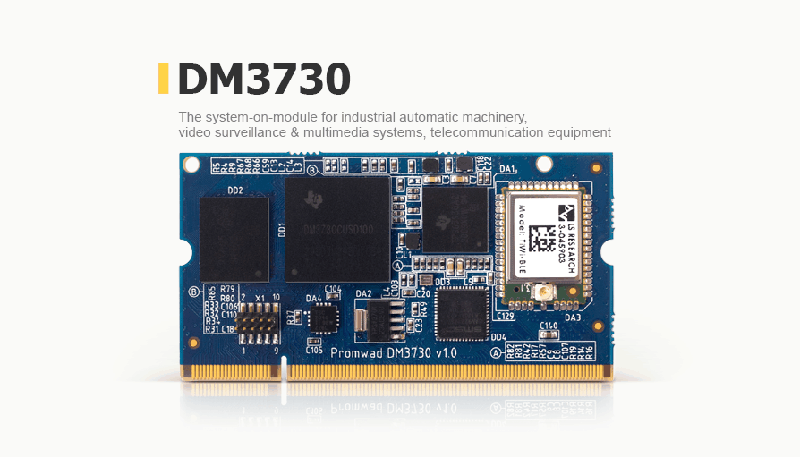The system-on-module based on TI DM3730
Challenge
To design the CPU module in the SODIMM-200 form factor, which helps cut the time, costs, and risks of designing new products.
Solution
We've chosen DM3730 processor from Texas Instruments with low power consumption as a core module. This CPU has advanced features for the user interface, such as OpenGL ES 3D graphics and rich capabilities for playback and recording of multimedia streams, including 1080p HD video.
The TI DM3730 module can be fitted with one of four TI processors, whichever best suits the required field of application, from the simplified AM3703 (minimal production cost) to the DM3730, which enables the use of the high-performance subsystem TI IVA2.2 (video/audio accelerator based on a DSP kernel) and the 2D/3D graphics accelerator.
Processors available (comparative table)
CPU | IVA2.2 subsystem | 2D/3D |
| DM3730 | + | + |
| DM3725 | + | − |
| AM3715 | − | + |
| AM3703 | − | − |
TI DM3730 key features
- TI Cortex-A8 microprocessor with a frequency of up to 1,000 MHz
- Up to 512 MB DDR and 512 MB NAND flash
- Interfaces: UART, USB Host/OTG, Ethernet, LCD/Touch, Camera, Audio, SD/MMC
- Optional: Wi-Fi, Bluetooth, and Bluetooth Low Energy
- Periphery support package for Linux
- Industrial use
- Can be used together with a Variscite motherboard
Fields of application
- Industrial automatic machinery
- Video surveillance system
- Telecommunication equipment
- Multimedia systems
TI DM3730 technical features
| Hardware | |
|---|---|
Processor | ARM CortexTM-A8 Kernel Coprocessor NEONTM SIMD High-performance video/audio accelerator (IVA2.2TM) (optional) Graphic accelerator POWERVR SGTM 2D/3D (optional) L1 cache 16 KB /16 KB, instruments and data L2 cache 256 KB Internal 64 KB SRAM |
Memory | Up to 512 MB LPDDR RAM Up to 512 MB NAND Flash Expansion - 2x SDIO/MMC |
| Interfaces | |
Network | 10/100 Mbit/s Ethernet |
Wireless network (optional) | 802.11 b/g/n Bluetooth 2.1 + EDR 802.11 b/g/n and Bluetooth 2.1 + EDR and Bluetooth 4.0 (BLE) |
Input/output interfaces | 1 x USB 2.0 High-Speed OTG 1 x USB 2.0 High-Speed Host 3 x UART 1 x I2C / 1 x 1-Wire / 2 x McBSP / 3 x SPI |
Display | 1 x LCD interface 1 x TV output Touch Screen Interface |
| Software | |
Operating system | GNU/Linux |
Supported file systems | EXT2, EXT3, FAT, NFS, JFFS2, UBIFS |
| Periphery drivers | NAND, UART, I2C, McSPI, McBSP, Ethernet, IPM\AC, USB Host, USB Device, WLAN, Bluetooth, SDIO/MMC, Touch Screen, DSS, CAM ISP, GPIO |
Assembly system | Buildroot with CodeSourcery ARM GNU/Linux complier |
| Developer environment | .NET framework (mono), glibc, optionally lua, python, perl |
| General features | |
Power | 3.7 V 1.8 V I/O |
Temperature | −40 to +85 °C |
Physical parameters | 68 mm x 35 mm SO-DIMM 200 pin connector |
Result
We've made a device with the following advantages:
- Various implementation options are possible, such as optional connection of Wi-Fi and Bluetooth interfaces and selection of the best processor for a specific project. The module can be manufactured both for commercial and industrial use with an operational temperature range of –40 to +85 °C
- If the DM3730 and the DM3725 are used, the DSP kernel can be applied and algorithms for digital processing of signals can be implemented. Moreover, the use of hardware codecs in these processors helps speed up the development process and achieve high performance
- A number of distributions based on a Linux or Android kernel can be used as operating systems. The CPU module is supplied with Linux BSP, including all the necessary drivers for the peripherals























